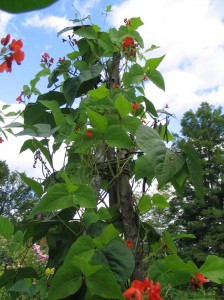|
|
Holes pock-marking the garden beds. Centers nibbled out of precious winter lettuce heads. Healthy parsley plants suddenly flattened and limp, the deep tap roots completely vanished. Carrots eaten from the bottom up. Voles have suddenly become garden enemy #1!
 Don’t know if it’s our aging cat providing less effective varmint control, or if it was the particular weather characteristics, but voles went from giving occasional trouble to becoming a major problem over this past fall and winter.
 When we had a stretch of warmish days a couple weeks ago I removed the row covers from the hoop house beds to water and found vole holes riddling the whole surface. They had eaten nearly all the seedlings of spinach and lettuce I planted in the fall to overwinter and now as I prepared to replant in all the empty spots, voles threatened any chance of getting early season greens. This called for an immediate solution.
 Don’t know where the initial idea came from but for the last couple years I have prevented rodent damage in the root cellar by applying orange essential oil or Citrasolve (an orange oil-based cleaner) to strips of fabric and laying them over the stored produce. Orange zest, a pleasant smell to us, apparently repels rodents.
 So I tried spraying citrasolve directly onto the wooden frames of the garden beds and dropping wood chips soaked in the liquid into the vole holes before raking the holes over – then re-covered the beds with the row covers. Two weeks later, there doesn’t appear to be any new evidence of voles. The smell dissipates in the hoop house much faster than in the enclosed root cellar so I have been re-applying regularly.
 As long as new generations of voles don’t adapt to the smell, orange zest offers a pretty easy way to prevent rodent damage. It’s also likely to become the scent I’ll most associate with winter gardening in the hoop house so I hope it doesn’t become repellent for me too!
Â
 scarlet runner pole bean (growing with purple peacock beans) Going through the newly arrived seed packets, I see a good mix of both old friends and new acquaintances.
This week I’ll plant Napoli carrots in the hoop house, a favorite for cold season sowing and sweet, early summer harvests. Inter-planted will be new comer, Easter Egg radish, apparently a multicolor, pastel mix of small round roots. Sounds pretty. But just in case they aren’t tasty and to extend the radish harvests, I’ll plant a row of good old Crimson Giant radish – big, mildly sweet, juicy, and maturing just a week later than Easter Egg.
Beans have become a passion of mine the last few years. Eric doesn’t share my love for fresh green beans but likes the elegant little French style haricot vert beans. Fedco offers a new variety of haricot vert called Masai that apparently doesn’t get stringy and tough if you don’t pick them every day. We’ll see if that’s true!
On the opposite end of the green bean spectrum, I’ve rediscovered the wonderfulness of Scarlet Runner beans. Not only are the red flowers and and mottled seeds exceptionally beautiful, the big, thick green seed pods are meaty and delicious. Perhaps it was all the rain that made those green beans extra good last August but after giving some to friends they declared them the best green beans ever tasted. I had  hesitated to share those jumbo beans in the past, assuming that the size and coarse outer texture of the bean would turn people off.  This year I will be more generous with my scarlet runner beans.
Last year I inter-planted scarlet runners with purple peacock, another pole bean with delicate purple flowers and long dark purple pods. When cooked they turn dark green. This year, I ordered a multi-colored mix of pole beans from Fedco.  Can’t wait to see what other colors and shapes the flowers, pods and dry seeds take.
Finally completed the 2010 seed orders last weekend. Between perusing the catalogues, inventorying the left over seeds from last year and deciding on the best varieties to buy, the annual seed order has, at least in my mind, become a major undertaking. I try hard not to peek at the seed catalogues that arrive before Christmas and then plunge into them after New Years to see what’s new and that I might have overlooked in past years. That’s the fun part. Making decisions is harder.
 To avoid over-complicating the process, I ordered only from the Maine triumvirate – my old standbys.
- Johnny’s – informative catalogue, comprehensive inventory, breeding program for northern varieties, superb service
- Pine Tree – caters to home gardeners – small seed packets for prices mostly under $1.50
- Fedco – entertaining catalogue, large inventory – prices mostly under $1.50/pkt.
For seeds not available from any of those three, I shop at the Gardeners Supply store in Burlington. They offer huge range of varieties in festive seed displays featuring unusual sources including some never seen European and Asian seed companies.  Fun,  but if you share my approach of growing a little of a lot, buying seeds at a store will get expensive. Â
We plant throughout the year, with at least 100 varieties of seeds, including multiple varieties of many veggies. It’s a delight to have the full palette of lettuce colors, smooth and spikey greens for every season, and tomatoes big and small, round and oval. Plus, with eight types of peppers, I can pretty much ensure that that whatever conditions the summer brings, we’ll get production from at least one. Last year was my worst pepper year ever but still the two serrano plants pumped out enough of the little peppers to freeze and use throughout the winter. I pick and pop them into the freezer bag, then take them out individually and while still frozen, cut them up for a fresh picante taste in salsas and currys.
Now onto the next set of garden tasks!
|
|

